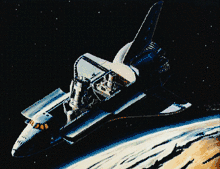Broad Band X-ray Telescope

Diagram of Astro-1 instruments with BBXRT on the right

Astro-1 payload in the Shuttle Bay illustration

STS-35, carrying ASTRO-1 with the BBXT heads into orbit, 1990
The Broad Band X-ray Telescope (BBXRT) was flown on the Space Shuttle Columbia (STS-35) on 1990 December 2-December 11, as part of the ASTRO-1 payload. The flight of BBXRT marked the first opportunity for performing X-ray observations over a broad energy range (0.3-12 keV) with a moderate energy resolution (typically 90 eV and 150 eV at 1 and 6 keV, respectively).
BBXRT was co-mounted with three ultraviolet telescopes HUT, WUPPE, and HIT for Astro-1 in 1990.[1]
This was, "..the first focusing X-ray telescope operating over a broad energy range 0.3-12 keV with a moderate energy resolution (90 eV at 1 keV and 150eV at 6 keV)." according to NASA.[2]
Hardware

Broad Band X-ray Telescope is on the left in this case, separately from the other grouping
See also
References
- ↑ UIT
- ↑ "The Broad Band X-ray Telescope (BBXRT)". heasarc.gsfc.nasa.gov. Retrieved 2018-07-10.
External links
- Broad Band X-ray Telescope (BBXRT. GSFC. NASA) on the internet
This article is issued from
Wikipedia.
The text is licensed under Creative Commons - Attribution - Sharealike.
Additional terms may apply for the media files.